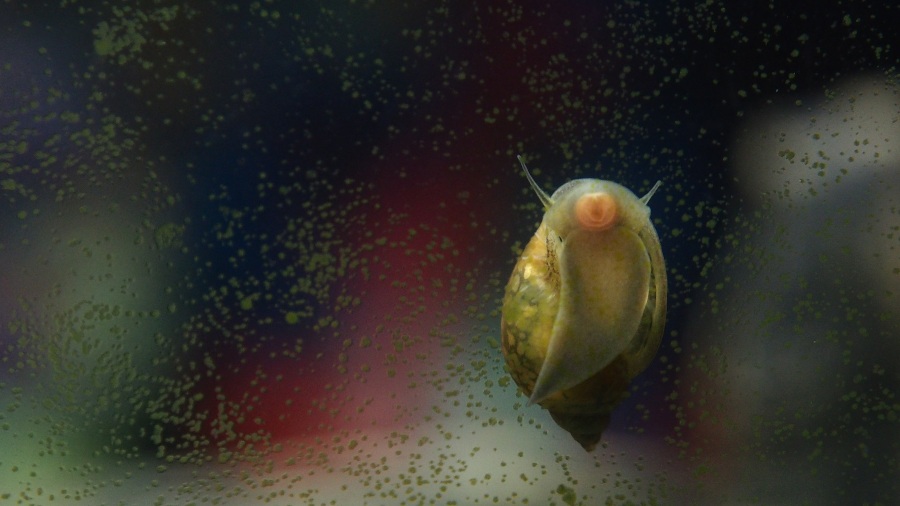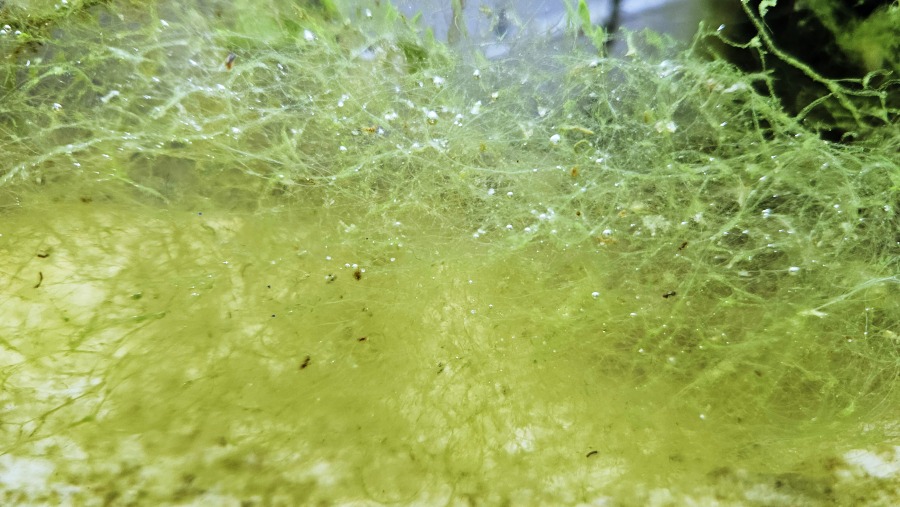Guide
Fighting algae in the aquarium: the right way to do it
Algae cause a lot of annoyance in aquariums and are a big problem – especially for beginners. Algae are a nuisance in aquariums, both for a Triops aquarium and an aquarium with fish and shrimps, but also for a biotope or aquascape. Algae are both a visual problem and degrade a painstakingly set-up aquarium, as well as a danger to the other plants. For some inexperienced aquarium keepers, the algae plague even leads to them despairing and giving up their hobby of breeding Triops. Of course, this doesn’t have to be the case, because there is a whole range of measures that can be taken to remedy this problem and prevent the algae from spreading. In this blog post, I explain how you can properly combat algae in the aquarium and keep the aquarium visually appealing.

Algae in the aquarium: What are algae?
Like bacteria, microorganisms and viruses, algae are widely represented in the environment and play an important role in the balance in biotopes. The algae family includes a wide range of plant species that do not belong to the so-called higher plants or mosses.
The following shapes and sizes of algae exist:
- Small unicellular algae
- Filamentous algae
- Macroalgae.
The macroalgae can reach a size of up to 60 metres. Algae in the aquarium are important for the biological balance, but can also become a nuisance.
Algae in the aquarium: How do algae develop?
There are various causes for an algae plague, which do not always originate from the Triops breeder. Since the ecological balance in a new aquarium has not yet settled, problems with algae are more common in newly set up aquariums. Common causes include too few and irregular water changes, water values and nutrients in the water. Light and nutrients are among the basics for algae growth – if there is an excess of both, the algae will grow and become a problem. Algae also multiply quickly when nitrite levels are too high.
Below we look at the most common causes of algae in the aquarium:
- Overfeeding
- Insufficient water change
- Triops stocking too high
- Few water plants
- Fertilisation
- Long illumination time
- Flow rate of the filter.
Plants need different lengths of time for photosynthesis. If the lighting phase is disturbed during this time, the plants will not grow as well and the growth of algae in the aquarium will be favoured. If, on the other hand, the lighting time is too long, this can lead to plants no longer being optimally supplied due to the lack of nutrients and algae growth is favoured. The Triops aquarium should therefore be lit for an average of 12 and a maximum of 14 hours.
If the flow rate of a filter is too low, fewer pollutants can be cleaned up. An overabundance of nitrate at a certain point can no longer be handled by plants, so algae can develop. But too high a flow rate should also be avoided, as this absorbs too much nitrate and consequently leaves too few nutrients for plants.
Triops and fish faeces are present as natural fertiliser in every aquarium. If additional fertiliser is used in the aquarium, this surplus can no longer be absorbed by the aquarium plants. Algae, on the other hand, can absorb almost unlimited amounts of fertiliser and thus grow magnificently.
What types of algae are there?
Below we take a look at the most important types of algae and how to combat them so that algae do not become a plague in the aquarium.
Green algae
Green algae are a type of algae that often occur in aquariums and are often a problem for the owner. Green algae form a fur-like coating on the aquarium glass. They are easily recognisable by long threads on the plants and grow mainly as a result of nutrient overload. They can multiply quickly and turn the water green, which affects the appearance of the aquarium. Green algae need light and nutrients such as phosphorus and nitrogen to grow. There are several factors that can lead to an outbreak of green algae, including too much light, too many nutrients in the water and an unbalanced ratio of plants to animals in the aquarium. To control green algae, these factors need to be regulated. This can be achieved by reducing the light time, regulating the nutrient supply and adding algae eaters.
It is also important to clean the aquarium regularly, removing damaged plants and excess dirt, as this can also lead to an increase in algae. Frequent water changes can also help to remove nutrients from the water and reduce the growth of algae. Green algae should be controlled as soon as possible to control growth and improve the appearance of the aquarium. To control green algae, triops growers should use a magnetic scraper and perform frequent water changes. However, it is important to note that complete algae removal can be difficult and it may take several attempts to solve the problem.
Beard algae
Bearded algae are a common type of algae found in aquariums and are often a problem for the owner. They are usually green or brown and have a stringy texture, which is how they got their name. This type of algae belongs to the red algae family and owes its name to its typical appearance. This reminds one of whiskers, but the red colour only appears after the alga has been immersed in alcohol. This robust species is relatively difficult to remove and settles on aquatic plants, decorations and the filter. Beard algae can grow on the walls, bottom and plants of the aquarium and affect the appearance of the tank.
Beard algae need light and nutrients such as phosphorus and nitrogen to grow. Too much light, too many nutrients in the water and an unbalanced ratio of plants to animals in the aquarium can lead to an outbreak of beard algae. To control growth, these factors need to be regulated. This can be achieved by reducing the light time, regulating the nutrient supply and adding algae eaters. If the plants are heavily infested, they should be removed completely.
Blue-green algae
Blue-green algae and algae in general in the aquarium can be a big problem and affect the well-being of the plants and animals in the tank. These algae are usually blue-green in colour and can grow and spread rapidly in a short time. Blue-green algae can grow on the walls, plants and bottom of the aquarium and affect the clear appearance of the water. One of the main reasons for the occurrence of blue-green algae in the aquarium is an unbalanced ratio of light, nutrients and plants. Excessive light, an overdose of nutrients in the water and a lack of plants that consume these nutrients can contribute to the growth of blue-green algae.
To control the growth of blue-green algae in the aquarium, it is important to regulate the ratio of light, nutrients and plants. This can be achieved by reducing the light time, regulating the supply of nutrients and adding algae eaters. It is also important to clean the aquarium regularly, removing damaged plants and excess dirt, as this can also lead to an increase in algae.
Algae in the aquarium should be controlled as soon as possible to ensure the well-being of the aquatic inhabitants. It is important to know that complete algae removal can be difficult and it may take several attempts to solve the problem. Frequent water changes are very important with blue-green algae, as the presence of this type of algae in the aquarium is an indication of poor water quality. As a result of too high nitrite and nitrate levels, a blue-green coating develops on plants and stones. The coating should be sucked off with a hose to avoid algae in the aquarium.
It is also important to note that some types of blue-green algae can be toxic, so consulting an expert may be necessary.
Brush algae
Brush algae are a type of algae that often appear in the aquarium and can be a challenge for owners. Like beard algae, they belong to the red algae family and are considered one of the worst types. They are caused by too many nutrients in the aquarium and a lack of CO2. Brush algae can be green, brown or reddish in colour and can affect the appearance of the aquarium. One of the main reasons for the growth of brush algae in the aquarium is an imbalance of light, nutrients and plants. Excessive light, an overdose of nutrients in the water and a lack of plants that consume these nutrients can contribute to the growth of brush algae.
To control algae in the aquarium, the ratio of plants, nutrients and light must be regulated. The aquarium should be cleaned regularly and damaged plants and excess dirt removed. There are also special cleaning tools suitable for removing brush algae from the aquarium, such as algae brushes or knives. However, it is important to be careful not to damage the aquarium and the plants in it. The tufted algae with the dark green to black colour must be removed immediately, as well as the infested plants must be removed completely. The gravel must also be vacuumed.
Thread algae
Filamentous algae is a type of algae that often occurs in aquariums and can be a challenge for aquarium owners. These algae in the aquarium are common and are usually found on plants and decorations. These algae have a thin, thread-like structure and can grow quickly, detracting from the appearance of the aquarium and affecting the well-being of plants and animals. They can reach a length of up to 20 centimetres. This species is relatively easy to remove by hand.

Diatoms
Diatoms are often mistakenly called brown algae. However, these only occur in the sea. Brownish algae in the aquarium indicate poor water quality and lack of light. They appear as black-green dots on leaves or as a thin layer on the glass. Partial water changes and the use of soft water help against this algae plague.
Algae in the aquarium: Conclusion
On the one hand, algae are important and belong in the aquarium, but if they grow wild they can become a bad nuisance. As a Triops grower, you invest a lot of time, work and also money in beautiful aquarium plants in order to set up a visually appealing aquarium. If the aquarium is then infested with algae, the joy is dampened and the fun of breeding is quickly gone. Frustration sets in. But this does not have to be the case and there are many ways to keep algae under control with a little patience and tact as well as the right prophylaxis. Enough aquatic plants that compete with the algae for food, moderate feeding and regular water changes are optimal prevention.